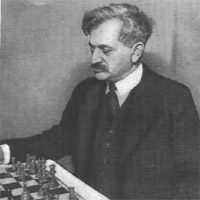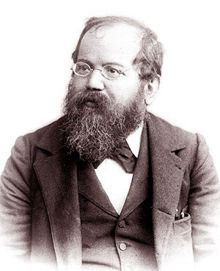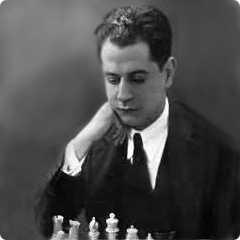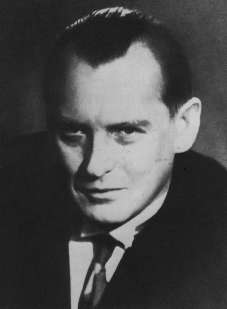Back to The Game of Chess...
Interestingly, any study of chess reflects on a character studies of its players. Those who wish to advance in chess fall back on research and games played by their predecessors. Therefore, I provide some insights from a book The Human Side of Chess, which Chris and I agreed is an ironic title - it shows that the human side is not another "side" but rather an intrinsic part of chess.
Emanuel Lasker
 I cite Lasker (1868-1941) first not by chronology, but rather because he figured out how the human plays a role in chess. Quite famously, he said "In life we are all duffers." Lasker approached chess with a pessimism that evoked the following question - why is "chessplayer" an occupation? Lasker made the observation that a chessplayer is absolutely no different than any other type of person. Perhaps due to his pessimism, he saw others as no less logical or gifted. Rather, Lasker believed that we are all simpletons who are ambling around with no clear purpose or goals in sight. Despite his pessimism, Lasker was a perceptive chess player who used the game as a gateway into the minds of his opponents. He used chess to classify people into categories and believed that this skill exceeded his perceptive one at the game. He manipulated the vulnerabilities in his opponent's chessplaying to take the correct risk, and thus used the power of character study against them. Lasker found the role of the human in chess, and is thus a good first study.(1)
I cite Lasker (1868-1941) first not by chronology, but rather because he figured out how the human plays a role in chess. Quite famously, he said "In life we are all duffers." Lasker approached chess with a pessimism that evoked the following question - why is "chessplayer" an occupation? Lasker made the observation that a chessplayer is absolutely no different than any other type of person. Perhaps due to his pessimism, he saw others as no less logical or gifted. Rather, Lasker believed that we are all simpletons who are ambling around with no clear purpose or goals in sight. Despite his pessimism, Lasker was a perceptive chess player who used the game as a gateway into the minds of his opponents. He used chess to classify people into categories and believed that this skill exceeded his perceptive one at the game. He manipulated the vulnerabilities in his opponent's chessplaying to take the correct risk, and thus used the power of character study against them. Lasker found the role of the human in chess, and is thus a good first study.(1)
Wilhelm Steinitz
 Lasker's first reasonable rival, Steinitz (1836-1900) is responsible for our modern conception of chess. Steinitz could be classified as a teacher in his long lifetime of chessplaying; he had a long string of admirers. Steinitz saw the beginning of chess as an equilibrium of white against black where flawless play by both sides maintains equilibrium. The equilibrium only shifts by continually improving one's position over another. This required mental intimidation, for no other disturbance may cause a confident expert to give up a flawed move. Steinitz served as a model, because his beliefs yielded well to winning patterns where the equilibrium constantly fell to the victor. These patterns could be communicated down the line to future generations of chess players. It is no question that Reinelli's assessment of Steinitz as "The Lawgiver" is true, for he formalized the rules by which chess is lost and won. Despite being a role model, Steinitz hit the ground hard in losing to Lasker - and his play never recovered. In his old age, Steinitz demonstrated that we all fail, even if we reach great accomplishment in our lifetimes. Steinitz recognized his importance while seeing that a new generation always overthrows the old.(2)
Lasker's first reasonable rival, Steinitz (1836-1900) is responsible for our modern conception of chess. Steinitz could be classified as a teacher in his long lifetime of chessplaying; he had a long string of admirers. Steinitz saw the beginning of chess as an equilibrium of white against black where flawless play by both sides maintains equilibrium. The equilibrium only shifts by continually improving one's position over another. This required mental intimidation, for no other disturbance may cause a confident expert to give up a flawed move. Steinitz served as a model, because his beliefs yielded well to winning patterns where the equilibrium constantly fell to the victor. These patterns could be communicated down the line to future generations of chess players. It is no question that Reinelli's assessment of Steinitz as "The Lawgiver" is true, for he formalized the rules by which chess is lost and won. Despite being a role model, Steinitz hit the ground hard in losing to Lasker - and his play never recovered. In his old age, Steinitz demonstrated that we all fail, even if we reach great accomplishment in our lifetimes. Steinitz recognized his importance while seeing that a new generation always overthrows the old.(2)
Jose Raul Capablanca
 Jose Raul Capablanca (1888-1942) is an odd one because he almost thought he wasn't human. Rather, he wrote many memoirs suggesting how his perception of the real world is one of witnessing the mechanism in all things. Capablanca's memoirs opened his way of thinking to others so that they could perceive him too as a machine - albeit one very good at the function of playing chess. Capablanca was a frustrated man, for the very fact that he perceived that good chess would require risk - and quite simply, he was not comfortable with risk. And by the same token, he considered himself a machine but was even more frightened that there could be a perfect chess machine out there. Capablanca lamented, "In effect, if one were satisfied to draw, we believe that it would not be impossible to draw all the games. To avoid drawing variations one might have to enter into inferior lines of play which might lead to disaster against a first-class opponent." Capablanca already forsaw the difficulties of computer chess. Capablanca feared if a machine - like him, but altogether more perfect - was to play. Chess is ruined if we don't believe that human intelligence is behind the moves!(3)
Jose Raul Capablanca (1888-1942) is an odd one because he almost thought he wasn't human. Rather, he wrote many memoirs suggesting how his perception of the real world is one of witnessing the mechanism in all things. Capablanca's memoirs opened his way of thinking to others so that they could perceive him too as a machine - albeit one very good at the function of playing chess. Capablanca was a frustrated man, for the very fact that he perceived that good chess would require risk - and quite simply, he was not comfortable with risk. And by the same token, he considered himself a machine but was even more frightened that there could be a perfect chess machine out there. Capablanca lamented, "In effect, if one were satisfied to draw, we believe that it would not be impossible to draw all the games. To avoid drawing variations one might have to enter into inferior lines of play which might lead to disaster against a first-class opponent." Capablanca already forsaw the difficulties of computer chess. Capablanca feared if a machine - like him, but altogether more perfect - was to play. Chess is ruined if we don't believe that human intelligence is behind the moves!(3)
Alexander Alekhine
 Alexander Alekhine (1892-1946) may well be the best modern chess philosopher. He rightly saw exactly what a real chess match symbolizes by attaching the game's details to matters of great import. Alekhine's chess was not so mechanical as Capablanca's, but rather engineered for drama. He frequently planted moves to challenge his opponents and keep them on edge. Alekhine showed that the fundamental act in chess is to bring possible sacrifice to the fore. He advocated good play as being thought-provoking and mind-twisting rather than methodical and flawless. And his great play proved that you don't need to play like a machine to do well! Thus, he supposed that chess must be played in a provoking way in order to be relevant in society. (4)
Alexander Alekhine (1892-1946) may well be the best modern chess philosopher. He rightly saw exactly what a real chess match symbolizes by attaching the game's details to matters of great import. Alekhine's chess was not so mechanical as Capablanca's, but rather engineered for drama. He frequently planted moves to challenge his opponents and keep them on edge. Alekhine showed that the fundamental act in chess is to bring possible sacrifice to the fore. He advocated good play as being thought-provoking and mind-twisting rather than methodical and flawless. And his great play proved that you don't need to play like a machine to do well! Thus, he supposed that chess must be played in a provoking way in order to be relevant in society. (4)
- Reinelli, Fred. The human side of chess. p. 120-126
- Reinelli, Fred. The human side of chess. p. 77-117
- Reinelli, Fred. The human side of chess. p. 147-158.
- Reinelli, Fred. The human side of chess. p. 180-192, 219.
